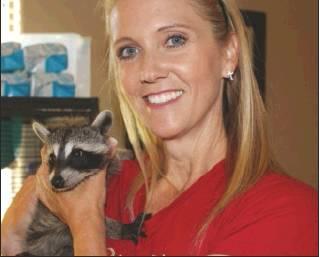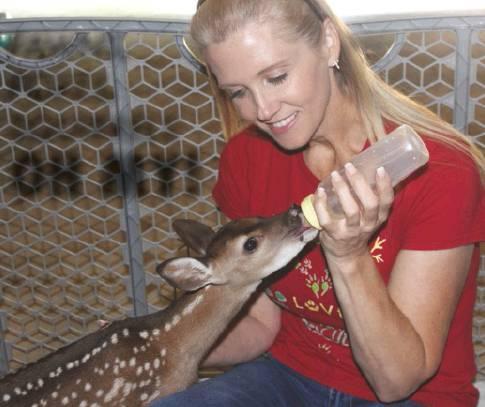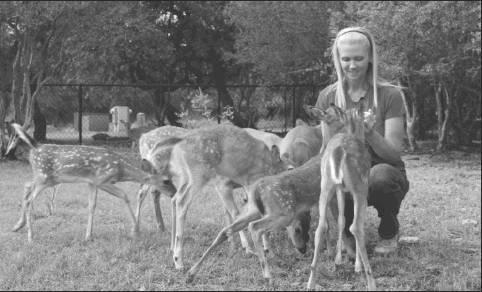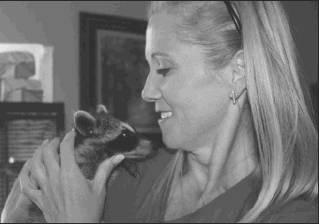FAWNS, FOXES, SQUIRRELS OH MY!
Tammy Kelley keeps the fawns in the side yard. The fox and larger squirrels are in back. The little raccoon, opossum and baby squirrels are in a room just off the kitchen. A tiny fawn has taken over the garage.
Of course, her refrigerator is filled with cottage cheese, milk and fruit and the kitchen counter is piled high with nuts and seeds to feed all the critters.
Tammy is a state-licensed wild animal “rehabber” and runs Keeping It Wild Rescue out of her home in Driftwood.
The premise of Keeping It Wild is pretty simple: People report a baby animal that is in some sort of distress. Tammy heads out in the SUV, assesses the situation and, if warranted, brings the animal home until it is safe to release it back into the wild.
Her area basically covers Hays, Comal, Guadalupe and Caldwell counties. She estimates 300 animals pass through her home annually. The state monitors her records and conducts inspections now and then.
She recently established Keeping It Wild as a non-profit, 501(c)(3) organization which means donations are now tax deductible. Since Tammy started rescuing wild animals in 2008, she and her husband Neal Kelley, a hospital administrator in Kyle, have pretty much picked up the tab for food, vet bills, water, etc. and turned over a large portion of their home to the animals. “My husband supports me totally,” she says.
Most are babies
Most of the animals that come to Keeping It Wild are small. “When you are dealing with an adult deer,” Tammy says, “it’s just hard. They are so large.”
The busiest time is “baby season” which runs from March to September. Some days she’ll get 12 phone calls reporting an animal in distress. She responds to most calls so she can see for herself what’s going on.
“When we come across something injured or suffering I just want to help. It stirs something inside of me,” Tammy explains.
She walks a fine line between nurturing the animal’s wild instincts and protecting it. For example, most of the 14 fawns she is now tending will be released into the wild next spring. Until then, they rely on Tammy for food and shelter. When she walks into the pen with food, the little fawns eagerly gather around her.
She releases the animals well away from a populated area. There’s a local wedding venue that accepts some and a 1,000-acre ranch outside of Wimberley where most go. “We never release within city limits. It’s just too populated,” Tammy says.
Ideally, an animal has its wild instincts when it is released and can survive on its own. Sometimes an animal will show signs of dependency — such as clinging to humans or the inability to find its own food — and will have to have a “soft release” where it is gradually weaned away from rehab. “When we release them we need them to have all their instincts for survival,” says Tammy.
There is a school of thought that nature should be allowed to run its course.
“Some people say leave it alone, just leave it alone and don’t get involved with nature. Just walk away,” says Tammy. “But God created all the creatures and He said they are good and what God loves, I love.”
Often the animals arrive injured. When a fawn comes in with a broken leg Tammy will try and let it heal on its own — as it would in the wild. Sometimes an animal has been hit by a car and is disoriented. In a case like that, the animal only stays at the rescue for a day or two until it gets it senses back. Nevertheless, about one-third of the animals need veterinary attention.
Most of the young animals are separated from their mothers at some point — the family dog may have killed a mother squirrel or a doe may have been shot or hit by a car. Sometimes well-meaning people take in a wild animal and try to make it a pet. At first, the animals are cute and cuddly, but at some point the wild instincts kick in and they become aggressive, too big or start biting. That’s when Tammy gets a phone call.
Get a professional
“The main thing we want to people to know is that it is illegal to rehab a wild animal on your own. You need to work with a trained, experienced rehabber,” Tammy says. “It never works out for the animal when people selfishly try to make it a pet. The shelters are full of animals if you need something to love on.”
Tammy is qualified to take in most mammals and is considering getting the training necessary to handle bird rescues. “There’s a huge need for bird rehabbers,” she says.
The largest group of animals she has is fawns which roam the spacious side yard. Her favorites however, are the opossums, an animal she says gets a bad rap. She talks lovingly about the animal’s docile nature and of its cleanliness.
The toughest animals to rehab are cottontail rabbits. Their digestive systems are difficult to replicate in a domestic situation.
Generally, fawns will stay at rehab 6-8 months; a raccoon five months.
She’ll even take in skunks, another animal which she defends, despite their smelly reputation. “A skunk gives its warning first,” Tammy explains. “The spray is the last defense. If they spray, that’s their defense and they have to recharge. They’ll only spray when they are directly threatened.”
For the record, Tammy has never been sprayed. She’s never taken in a rabid animal, as far as she knows, but she has been bitten plenty of times — that comes with the job.
Tammy is a retired martial arts teacher and had a studio in Lockhart where she taught kids and women’s self-defense courses. She always loved animals and started training under another rehabber and after she took in her first fawn she was hooked.
She has three sons who used to help with the animals, but they are grown now and on their own. Tammy has a daily routine of feeding the animals, filling out her log book and cleaning the cages and animal areas. She has had a few volunteers over the years, but most people want to interact with the baby animals. When it comes to scooping out the pens, well, that’s not a popular job.
A few businesses and individuals have contributed to the effort and Tammy hopes that, now that Keeping It Wild is a tax-deductible non-profit organization, more donations will come in.
It’s not easy to take a vacation when you have dozens of animals to take care of. Tammy arranges with a nearby certified rehabber to watch over things when she and Neal are gone on their annual mission trip to Kenya.
If you want to volunteer or if you find an animal in distress, Tammy says to give her a call at 512-738-1926 or email her at keepingitwildrescue@gmail. com.
“What we are trying to do is what is best for the animals,” says Tammy, summing up her rehabbing mission.





